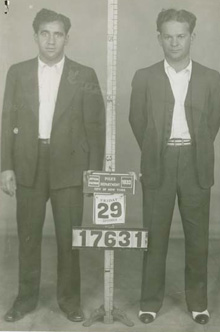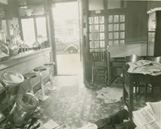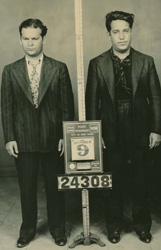- Home |
- About |
- Contact Us |
- RSS
Murder, Inc. - The Syndicate's Killing Team
Murder, Inc. were a band of ruthless killers from Brooklyn who were retained to conduct contract killings for the top echelons of organized crime throughout the United States in the 1930s and 1940s.

Though its members were involved in a variety of illicit activities including loan sharking, prostitution, gambling, bootlegging and labor racketeering, they became infamous for their role as the New York syndicate's so-called "execution squad." However, their reach extended far beyond the East Coast, they were implicated or suspected in numerous killings across the United States, as far away as Florida, Los Angeles and Detroit.
Based out of a 24 hour coffee shop and candy store called Midnight Roses at Saratoga and Livonia Ave in Brownsville, its members were always on call at a moment's notice to go to an assignment once the directive was handed down.
By the 1930s the ruling elite of organized crime on the East Coast including Louis "Lepke" Buchalter, Albert Anastasia, Lucky Luciano, Meyer Lansky, Dutch Schultz, Benjamin "Bugsy" Siegel, Frank Costello and Joe Adonis, had assembled into a panel of sorts (sometimes called "The Syndicate" or "Combination") and decided that a "business-like" atmosphere should prevail as much as possible in dealing with disputes among the varying groups of the day. Once a dispute needed resolution, Murder, Inc. was often called in to do the heavy lifting of actual settling.

There were two sub groups within Murder, Inc., and they were organized along ethnic lines, Jews and Italians. Each group was generally called to eliminate targets within its own ethnicity, although this wasn't always the case. Louis "Lepke" Buchalter, the infamous labor racketeer and gang chieftain, was in charge of the Jewish members, where Albert Anastasia (also know as "The Mad Hatter" and "Lord High Executioner" for his love of killing), directed its Italian members.
Some of the more prominent members on the Jewish side were Abe "Kid Twist" Reles, Harry "Pittsburgh Phil" Strauss (also known as "Pep"), Martin "Buggsy" Goldstein, Allie "Tic Toc" Tannenbaum and Seymour "Blue Jaw" Magoon. All vicious killers--most eventually went on to die horrible deaths themselves.
The leaders on the Italian side, were Louis Capone (no relation to Al Capone), Harry "Happy" Maione and Frank "Dasher" Abbandando, who all would find themselves in the electric chair for their work as Murder, Inc. henchmen.
Once a murder contract had been ordered by the Syndicate, the usual procedure would be for someone who knew the victim to take the killer or killers to see what the victim looked like, then the "case" would be passed onto the killers who would then plan and carry out the execution. Rarely did the execution squad know its target personally, which is one reason why the murder ring lasted so long.
This system also led to at least one case of mistaken identity when a NYC classical music publisher, Irving Penn, was shot to death on the mistaken believe that he was intended target Philip Orlovsky, a labor union honcho scheduled to testify against Lepke.
Another example of a victim whose death came at the hands of slayers unknown to him was in the killing of Detroit gangster Harry Millman, on November 25, 1937. Millman, a wayward Purple Gang member, who created such consternation in Detroit both among his own gang and the rival Licavoli mob that members of Murder, Inc. were imported in to do away with him in a popular bar after other attempts to remove him (including a failed car bombing which caused the death of an unlucky valet attendant) failed. Millman, whose arrogance, drunkenness and "pathological hatred" of the Sicilians led to orders to remove him, was supposedly taken out by Strauss and Maione when they walked into the bar and began shooting. Because the men were unknown to anyone in the local underworld there were no eyewitnesses who could identify them.

Extensive preparations were usually undertaken by the assassins in order to evade apprehension for their crimes. Typically a car was stolen weeks prior the killing then hidden in a garage. A license plate was then stolen from another car and affixed to the car in the garage, making it very difficult to identify the car. The stolen car was eventually used for the hit, and a trailing car was employed (usually also stolen), whose job it was to ram or block tailing police cars from their target. Weapons were acquired, used and then immediately destroyed. Any remaining evidence was usually burned, along with the bodies and cars, in many cases.
Some of the men were experts in the use of ice picks, where others used garrotes, shotguns or their own hands. Strauss and Maione were especially fond of killing, volunteering for every assignment they could get their hands on, where Reles saw killing as means of climbing the ladder further up into "The Syndicate."
The group's most famous hit was that of Dutch Schultz at the Palace Chop House in Newark, N.J., on October 23, 1935. Mendy Weiss, Charles Workman and one other were dispatched to eliminate Schultz, who the Syndicate feared was plotting to assassinate then New York Special Prosecutor Thomas Dewey thereby bringing too much "heat" onto gangland operations. Dewey at the time was leading the charge against organized racketeering and corruption, and Schultz had become one of Dewey's number one targets for prosecution.

That night the squad managed to kill not only Schultz but also his trusted aides, Otto "Abbadabba" Berman, Abe Landau, and Lulu Rosenkrantz all of whom were with him at the restaurant that night.
The group were also responsible for several killings at the behest of a dangerously paranoid Lepke Buchalter, whose mission it was to eliminate any potential witness against him--anyone who he suspected had a sliver of criminal evidence or could testify against him on any matter was targeted for execution. Certain members of the group such as Allie Tannenbaum and Mendy Weiss were kept on a weekly salary/retainer by Buchalter.
Ironically, the September 13, 1936, murder of one of these "witnesses," Joe Rosen, a Brownsville candy store owner, was to become the undoing of Lepke, Emanuel Weiss and Louis Capone all of whom went to the electric chair for it. Years earlier Lepke had forced Rosen out of his trucking business in a labor racketeering dispute and had tried to keep a bitter Rosen appeased as he kept demanding compensation for his loss. Eventually, Lepke set Rosen up as the proprietor of this candy store, but when Rosen ran into financial trouble with the business he demanded more help or he would "talk" to Dewey's agents about what he knew about Buchalter. With that, a rage filled Lepke signed Rosen's death warrant.
In 1940, when indictments were secured against Reles, Goldstein and Maffetore for a 1933 murder on the testimony of a police informant named Harry Rudolph, Reles flipped and agreed to testify against his colleagues on over 200 unsolved murders. Whether it was new found religion or a sudden conscious, Reles turned his back on just about every colleague and associate he had maintained throughout his working life.

According to the 1951 Burton Turkus/Sid Feder, book, Murder, Inc., in which Turkus recounted his experiences as the Assistant District Attorney and main prosecutor on the Murder, Inc. cases, Reles possessed a photographic memory of almost every minute of his life including the murders he was involved in, as well as dates, who was involved, where they took place and how they were committed.
Like some kind of demonic raconteur, Reles spilled the details on countless murders, political corruption at the highest levels, and the connection between the national syndicate and regional organized crime groups. He also helped close the book on several homicides, including the Dutch Schultz case. His main function was to corrobate other witnesses's testimony, something required under New York state law to convict a defendant on a murder charge.
Eventually, along with Reles, Allie Tannenbaum, Seymour Magoon, Abe "Pretty" Levine, and Sholem Bernstein all turned informant and also agreed to testify against their former colleagues.
The men were held in a secure location in Coney Island, Brooklyn called the Half Moon Hotel. Despite the squad of police officers assigned 24/7 to guard the witnesses, on November 12, 1941, Reles was found dead on a landing seven stories down from his room. To this day there is still controversy about whether Reles tried to escape, fell as a result of a practical joke gone awry or was pushed out the window by police who either despised him or were paid off by "The Syndicate" to do the deed. It was said of Reles, "The canary could sing but he could not fly."

Murder or mishap, Reles was no longer an effective witness and several of the remaining cases for which he was scheduled to testify fell into disarray. It is speculated that Reles's death led directly to the demise of big investigations of Albert Anastasia and to Los Angeles case filed against Benjamin "Bugsy" Siegel for the murder of Big" Harry Greenberg. Reles possessed knowledge of many details in both cases.
On the combined testimony of the Murder, Inc. defectors, by the middle of the 1940s, Louis "Lepke" Buchalter, Harry "Pittsburg Phil" Strauss, Louis Capone, Harry "Happy" Maione, Mendy Weiss, Frank "Dasher" Abbandando, and George "Buggsy" Goldstein all found their ways to the electric chair at Sing Sing. Several other cases were tried and resulted in prison sentences but not the death penalty.
For years after the demise of Murder, Inc. the case was a hot button issue, resulting in promotions, demotions, resignations, accusations and fresh investigations of corruption owing to Reles' death. To this day, the cause of his death is considered an unsolved mystery.
- In October 1957, Albert Anastasia was brutally (and famously) gunned down at the barber shop in the Park Sheraton Hotel in Midtown Manhattan.
- Lepke Buchalter is to date (2012) the only major syndicate leader to be executed via death penalty.
- Peter Falk played Abe Reles twice in 1960. In the movie "Murder, Inc." and television series, "The Witness."
Some of these sites were used as source material for this entry and may be of interest to those looking to learn more about this person/topic.
SEE ALSO
 Copy the text below to cite your paper or article:
Copy the text below to cite your paper or article: 

